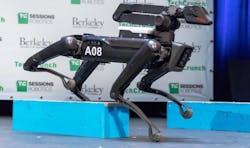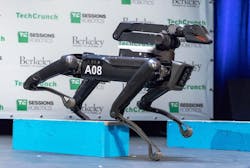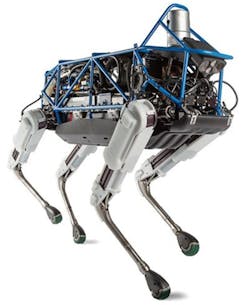Boston Dynamics founder Marc Raibert, speaking at a recent TechCrunch robotics conference at UC Berkeley, surprised everyone by saying that its SpotMini robot will go on sale in 2019. SpotMini is a small four-legged robot that weighs 25 kg (30 kg if you include the arm). It’s all-electric and can go for about 90 minutes on a charge, depending on what it’s doing (Fig 1). Raibert said that SpotMini is the quietest robot Boston Dynamics has ever built. Eventually, the company hopes to sell it for use in people's homes.
1. At the TechCrunch robotics conference, a human operator pilots a Boston Dynamics' SpotMini robot, enabling it to walk sideways over obstacles.
SpotMini was introduced in 2017 and is based on the company’s “bigger brother” quadruped Spot (Fig. 2). SpotMini inherits all of the mobility of Spot, with the added ability to pick up and handle objects using its five-degree-of-freedom arm and beefed-up perception sensors. The sensor suite includes stereo cameras, depth cameras, and position/force sensors in the limbs. These sensors help with navigation and mobile manipulation. A human operator pilots the SpotMini, giving commands about where to go, but not how to position its legs.
The company currently has 10 SpotMini prototypes, and is working with manufacturing partners to build the first 100 SpotMinis later this year for commercial purposes. They’re scaling production with the goal of selling SpotMini in 2019. They haven’t announced price yet, but said that the latest SpotMini prototype cost 10 times less to build than the iteration before it.
2. Spot is an electrically powered and hydraulically actuated four-legged robot. It senses rough-terrain environment using LiDAR and stereo vision in conjunction with a suite of on-board sensors to maintain balance and negotiate rough terrain. The robot carries a 23-kg payload and operates for 45 minutes on a battery charge.
What Can It Do?
The dog-like SpotMini robot climbs up and down stairs. The first version of the SpotMini walked, rolled over, and even put objects in a dishwasher. Last year, it was revamped and can now walk by itself using autonomous navigation.
The company released several videos that showed the SpotMini in action. One video shows SpotMini approaching a door and subsequently met with resistance in the form of a person wielding a hockey stick:
Specifically, he says, "I think people think that it’s easy to get around with wheeled [robots], but that’s really not the case. Every place you go has some obstacle that wheeled things struggle with,” like going up and down stairs for search-and-rescue missions. “We think SpotMini can go to a much larger fraction of places.”
Among the other possible applications for the SpotMini robots could be security patrols or to help construction companies keep tabs on what's happening at building sites. Raibert said that SpotMini can be customized with attachments and extra software for particular jobs.
SpotMini uses stereo cameras. It perceives its surroundings with a sophisticated 3D vision system, and can even make its own way through a warehouse without user input. With the help of a neck attachment, SpotMini can grab the newspaper for you and also play fetch.
Buyers will eventually be able to mount their own hardware on SpotMini’s back. Boston Dynamics is also working on its own add-on packages, such as a surveillance package with special cameras that can mount on the back. And an arm that helps the robot open doors will be an extra option that’s removable.
The CEO explained that the robot is actually designed to be a platform with ports to connect third-party hardware and software. Boston Dynamics is developing some apps and reference packages for SpotMini, such as a surveillance package that adds special low-light cameras to the robot. It’s also looking at other possible uses for robots in areas such as construction and mobility.
About the Author

Sam Davis
Sam Davis was the editor-in-chief of Power Electronics Technology magazine and website that is now part of Electronic Design. He has 18 years experience in electronic engineering design and management, six years in public relations and 25 years as a trade press editor. He holds a BSEE from Case-Western Reserve University, and did graduate work at the same school and UCLA. Sam was the editor for PCIM, the predecessor to Power Electronics Technology, from 1984 to 2004. His engineering experience includes circuit and system design for Litton Systems, Bunker-Ramo, Rocketdyne, and Clevite Corporation.. Design tasks included analog circuits, display systems, power supplies, underwater ordnance systems, and test systems. He also served as a program manager for a Litton Systems Navy program.
Sam is the author of Computer Data Displays, a book published by Prentice-Hall in the U.S. and Japan in 1969. He is also a recipient of the Jesse Neal Award for trade press editorial excellence, and has one patent for naval ship construction that simplifies electronic system integration.
You can also check out his Power Electronics blog.



